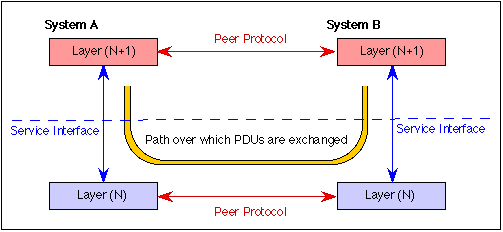
Protocol layers may be defined in such a way that the communications within a layer is independent of the operation of the layer being being used. This is known as "peer-to-peer" communication and is an important goal of the OSI Reference Model.
Each layer provides a protocol to communicate with its peer. When a packet is transmitted by a layer, a header is added to the data to be sent. The protocol data unit so-formed, is passed via a service access point to the layer below. This is then sent using the service of the next lower protocol layer.

Peer to peer communication using the services of a lower layer
The figure below provides an example of peer-to-peer communication between two End Systems (ES). In this case, the transport protocol entities communicates end-to-end using the services of the network layer below. The peer-to-peer communication takes place between the end systems using a communications protocol.
In the case of the link layer, the communication takes place using the service of the physical layer. The communication takes place with the peerlink protocol in the next directly connected system (either an Intermediate System or an End System).

Peer-to-Peer communication between protocol layers
Historical Note relating these diagrams to the OSI Reference Model:
The concept of peer to peer cvommunication was important goal of the OSI Reference Model.
In this each layer provides a protocol to communicate with its peer. When a packet is transmitted by a layer, a header consisting of Protocol Control Information (PCI) is added to the data to be sent. In OSI terminology, the packet data (also known as the Payload) is called a Protocol Data Unit (PDU). The packet so-formed, called a Service Data Unit (SDU) is passed via a service access point to the layer below. This is sent using the service of the next lower protocol layer.
The PDUs exchanged have two parts: a header (also known as the Protocol Control Information (PCI)) and a payload (also known as a Service Data Unit (SDU)). The protocol does not define or constrain the data carried in the payload part. It does specify the format of the PCI, defining the fields which are present and the way in which the patterns of bits are to be interpreted.
A more detailed example of the interaction between OSI layers is provided in an example.